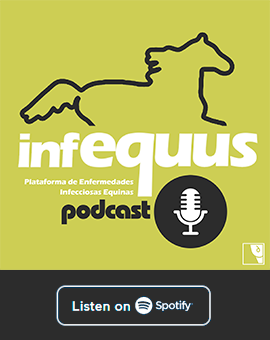Botulism
Etiology
Botulism is a neuromuscular disorder caused by neurotoxins of Clostridium botulinum, an anaerobic rod shaped bacterium which forms spores. Eight neurotoxins have been isolated from C.botulinum, but clinical botulism in horses has been attributed to types A, B, C and D. Spores are highly resistant to heat, light, and drying. Toxins may be released by cell lysis or by diffusion trough the cell wall.
Epidemiology
Botulism has been reported worldwide, but its distribution is not uniform. Different types have been isolated from soil of different areas, being some types more common in certain areas. For example, in the United States, horses are most often affected with type B or C botulism; however, type A botulism is predominant in adult horses and foals in the Western United States.
Pathogeny
Botulism may occur after ingestion of preformed botulinum toxin in contaminated feed, ingestion of spores with the production of toxin within the gastrointestinal tract (toxicoinfectious botulism), or the contamination of wounds with C.botulinum.
In adult horses the most common type of botulism is produced by ingestion of preformed botulinum toxin in decaying vegetable matter. Toxicoinfectious botulism is most common in foals i.e. the shaker foal syndrome, caused by the growth of C.botulinum in the gastrointestinal tract.
Botulism intoxication occurs by three distinct stages: binding to the target cell and internalization, translocation, and inhibition of neurotransmitter release. Once bound to the cell surface, neurotoxin is internalized by endocytosis, and after internalization, the toxin cannot be neutralized by antitoxin.
Clinical signs
Clinical signs are related to the interference with the acetylcholine release at the neuromuscular junction caused by the exotoxin and include dysphagia, flaccid paralysis; diminished pupillary reactivity, decreased eyelid, tongue and tail tone, and progressive flaccid tetraparesis and tetraplegia. The time to the onset of clinical signs after exposure to toxin varies from 12 hours to several days. Sudden, unexplained death of one or more horses may be the initial sings of an outbreak. Muscle trembling and weakness may be apparent, particularly in foals. In adult horses pharyngeal paralysis is often seen, and may be confirmed by endoscopic examination. Death is generally attributed to respiratory failure secondary to respiratory muscle paralysis.
Diagnosis
The diagnosis of botulism is primarily based on the basis of history and clinical signs after exclusion of other diagnostic possibilities. Definitive diagnosis is based on detection of toxin in serum, faeces, gastrointestinal (GI) contents or feed. A variety of tests, including ELISA, RIA, passive haemagglutination and PCR have been described for identification of botulinum toxin; however, the diagnostic test of choice is still mouse inoculation because it is the only one that detects active toxins. The serotype is determined by co-injection of mice with suspect samples and specific antisera. Isolation of C.botulinum or its toxin from feed, faeces or GI contents or from lesions or wounds is strong evidence of infection.
Treatment
The efficacy of early administration of antitoxin in improving survival has been clearly demonstrated for humans and horses. Respiratory failure is almost uniformly the cause of death. Adult horses and foals with mild respiratory failure can frequently be treated with intranasal oxygen administration, and repeated arterial blood gas (ABG) monitoring to detect worsening respiratory failure during the first 24-48 hours.
Antimicrobial administration is frequently used to prevent or reduce some of the complications, for example those caused by dysphagia. Antimicrobial drugs that might potentiate neuromuscular blockage should be avoided.
Nutritional management must be considered, and nursing care is an important part of the treatment, too.
Survival rate in treated foals less than 6 months is greater than 90%.
Prevention and control
Appropiate vaccination is thought to be nearly 100% protective in adult horses, although, foals born to vaccinated dams can present botulism, suggesting reliance on passive transfer of immunity for protection of foals may be inadequate in endemic areas.
Public Health Considerations
There is no zoonotic potential.
References
- ‘Equine Infectious Diseases’, Debra C. Sellon, DVM, PhD, DACVIM and Maureen T. Long, DVM, PhD, DACVIM. SAUNDERS ELSEVIER.
- http://www.cfsph.iastate.edu/Factsheets/es/botulism-es.pdf

